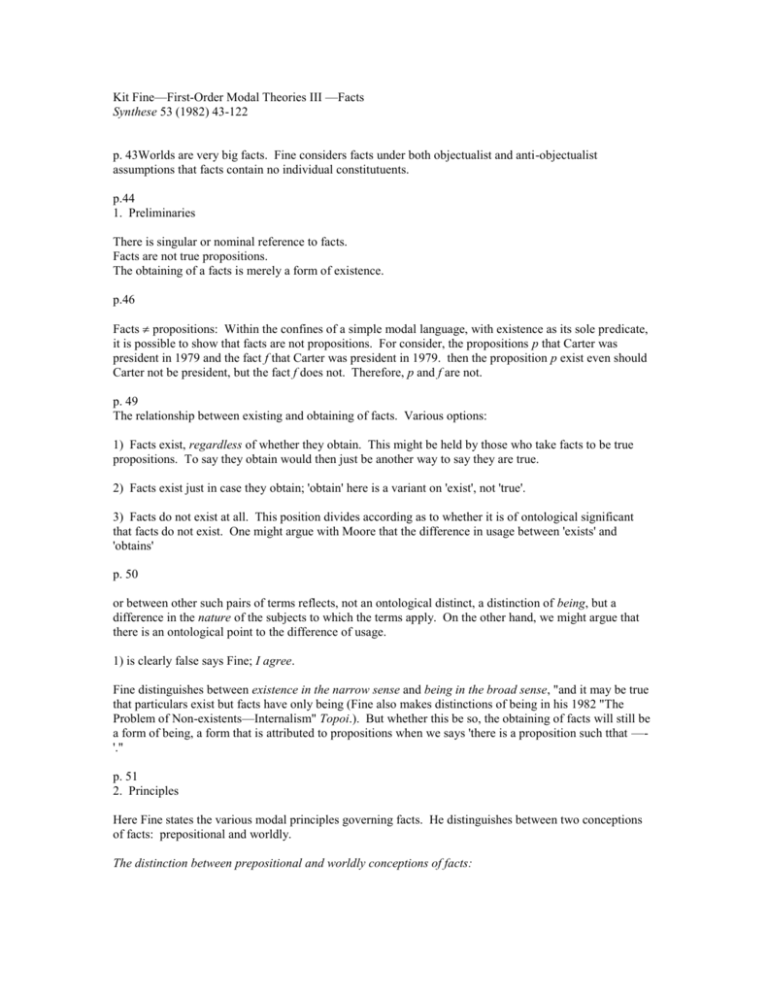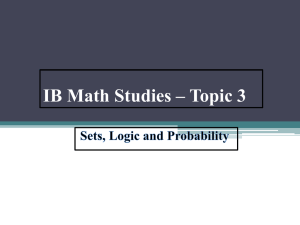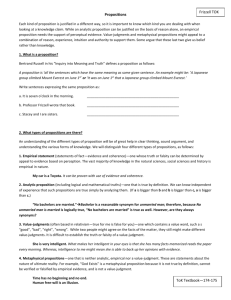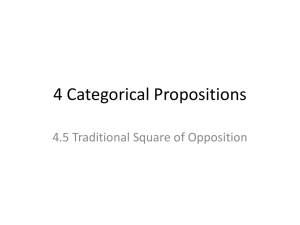Kit Fine--Facts
advertisement

Kit Fine—First-Order Modal Theories III —Facts Synthese 53 (1982) 43-122 p. 43Worlds are very big facts. Fine considers facts under both objectualist and anti-objectualist assumptions that facts contain no individual constitutuents. p.44 1. Preliminaries There is singular or nominal reference to facts. Facts are not true propositions. The obtaining of a facts is merely a form of existence. p.46 Facts propositions: Within the confines of a simple modal language, with existence as its sole predicate, it is possible to show that facts are not propositions. For consider, the propositions p that Carter was president in 1979 and the fact f that Carter was president in 1979. then the proposition p exist even should Carter not be president, but the fact f does not. Therefore, p and f are not. p. 49 The relationship between existing and obtaining of facts. Various options: 1) Facts exist, regardless of whether they obtain. This might be held by those who take facts to be true propositions. To say they obtain would then just be another way to say they are true. 2) Facts exist just in case they obtain; 'obtain' here is a variant on 'exist', not 'true'. 3) Facts do not exist at all. This position divides according as to whether it is of ontological significant that facts do not exist. One might argue with Moore that the difference in usage between 'exists' and 'obtains' p. 50 or between other such pairs of terms reflects, not an ontological distinct, a distinction of being, but a difference in the nature of the subjects to which the terms apply. On the other hand, we might argue that there is an ontological point to the difference of usage. 1) is clearly false says Fine; I agree. Fine distinguishes between existence in the narrow sense and being in the broad sense, "and it may be true that particulars exist but facts have only being (Fine also makes distinctions of being in his 1982 "The Problem of Non-existents—Internalism" Topoi.). But whether this be so, the obtaining of facts will still be a form of being, a form that is attributed to propositions when we says 'there is a proposition such tthat —'." p. 51 2. Principles Here Fine states the various modal principles governing facts. He distinguishes between two conceptions of facts: prepositional and worldly. The distinction between prepositional and worldly conceptions of facts: This is most helpfully done in terms of how the identity of facts is to be accounted for, of what one might call their ontological genesis. Propositional conception: Facts will be derivative from or posterior to the propositions. The propositions will enter into the explanation of the identity of the fact to which it corresponds. The exact nature of the explanaion will depend upon the type of prepositional conception in question. On one view, there will be a simple factforming operation, F, applying to any true proposition p p.52 to yield the corresponding fact F(p). On another, and perhaps more plausible, view, there will be a simple operation C of concretization, that applies to a property P an an individual x had by P to yield a new object C(P,x), the P-ness of x. The facts will then result from applying this operation to the property of truth and a proposition. Thus, on this view, the facts will belong to a broader category of objects, that include possibilities, necessities, likelihoods and certainties, all obtained by 'concretizing' the appropriate property. On the worldly conception of facts, their identity will not be explained in terms of propositions. It will either be taken as primitive or, more plausibly, will independently be explained. The most natural view of this sort will hold that facts are structure entities or complexes, built up in certain characteristic ways from their constitutents. Propositions don't enter into the analysis of facts on this view, but there is still a correspondence between the structure of facts and of propositions, at least on a structure conception of propositions. p.54 Fine speaks of the relationship of underlying between facts and propositions. On the worldy conception, there may be no fact corresponding to each true proposition, it may be held that to each true proposition there is an underlying fact that verifies it, should it be true. Thus the facts will be determinative of reality, even if they are not in correspondence with the true propositions. The worldly and prepositional conception of facts are not two views on a single category, but two different categories. Ordinary language use refers to the prepositional facts. p.55 Fine uses 'truth' to denote prepositional facts and 'circumstance' to denote worldly facts. Identity Principles These principles are best approached p.56 through the study of the existence and identity-conditions for the objects in question. Identity principles may be internal or external, relative or absolute. Internal principles are intra-worldy. In regard to existence, they state which objects exist within each world; and in regard to identity, they state when two objects are identical within a world. Exteranl principles are tras-worldly. The principles are relative when objects from another catgory of objects are presupposed, absolute when not. There will be four separate sets of questions to consider concerning the two conceptions of facts. p.58 Althoughteh acct of the identity conditions for facts in terms of propositions aor proposition sturc is very natural, there is an opposing, and quite different, account in terms of what one might call empirical content. Under this account, two facts will be identitcal when they necessarily co-exist, i.e., when it is necessary that the one exist just in case the other does. This new principle might then be applied to either turhs or circusmstances. The present criterion, once it is detaches from questions of prepositional identity, is best seen as arising from the demand that facts be empirical entities. Roughly speaking, we may say that empiricial entities are ones that are empirically distinguishable, where empirical distinctions are ones that make a possible difference to the world. p.59 Is the distinction between empirical and structural conceptions a reflection of a genuince difference? Yes. There are four different sorts of fact. p.63 Existence Principles The truths of each world are those that correspond to the true propositions. The internal existence conditions for circumstances are stated in terms of their correspondence to definite propositions. p.64 The existence conditions of a facta re not the truth-conditions of some proposition. For given any object whatever, its existence conditions will be the truth-conditions of a proposition, viz., the proposition that the object exists. In the case of facts, though, the proposition can be stated without circularity, not as the prp that the fact exists, but as the proposition that gives the inner content of the fact. Each true proposition is the existence condition for a truth. Consider the proposition that Socrates does not exist. In some possible world, thesis proposition is true, But is there, in that world, a fact that Socrates does not exist? I think not; for how can the fact exist when the individual does not? The principle "no individual, no fact" fas a great deal of intuiative appeal. It is essential to this piece of resoning, though, that we take an objectualist stand on facts, according to which individuals, p.65 as opposed to their concepts, can actually be constituents of facts p.66 Fine distinguishes between the inner and outer turht of a proposition. A proposition has outer truth if it is simply true and it has inner turth if, in addition, it exists. thus the propositions that Socrates does not exist has outer truth in a world in which Socarates does not exist, but not inner truth. p. 67 The Correspondence Theory There is a circularity in trying to explain the correspondence theory on the prepositional conception of facts. p.72 On the circumstance conception, for each proposition there will not correspond a circumstance. p.73Rahter, the exact match between true proposition and fact must give way to the less direct relation of underlying. Thus if a ocrrespondence theory of truth is to be plausible, it is the verification by facts, not the correspondence with propositions, that is to be the key relation. Problem: Why not use the constituents of the facts in place of the facts as those entities that underly true propositions? p. 73 Facts can explain the exemplification of an abstract object by a concrete object.









